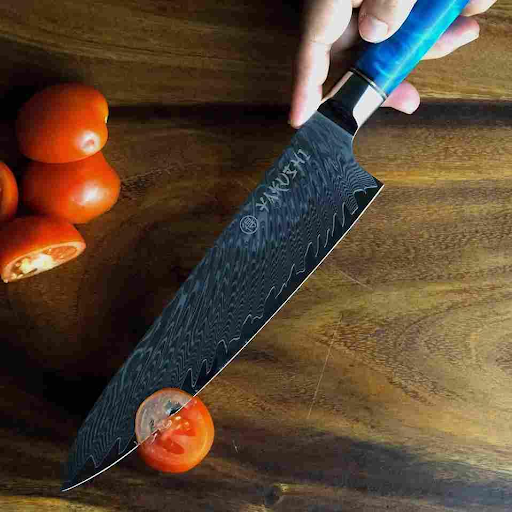In the world of culinary tools, few items evoke as much admiration and intrigue as the handmade Damascus chef knife. Renowned for its stunning aesthetics and exceptional functionality, each blade represents a rich tradition of craftsmanship that has been honed over centuries. This blog will explore the intricate artistry behind these knives, discussing their unique features, the forging process, and why they have become a must-have for both professional chefs and home cooks alike.
What is a Damascus Chef Knife?
At its core, a handmade Damascus chef knife is characterized by its unique blade pattern, which resembles flowing water. This distinct appearance comes from the use of layered steel, where different types of steel are forge-welded together. The process creates a blade that not only looks exquisite but also offers superior strength, sharpness, and durability.
The versatility of a chef knife is integral to any kitchen, making it an essential tool for chopping, slicing, and dicing various ingredients. What sets the Damascus knife apart is not just its functionality but also its craftsmanship, making it a true work of art.
The Art of Crafting a Damascus Knife
Creating a handmade Damascus chef knife is an intricate process that requires skill, experience, and dedication. Below are the key stages involved in crafting these exceptional knives:
1. Selecting the Steel
The first step in the process is selecting high-quality steels. Craftsmen often choose high-carbon steel for its ability to hold an edge, combined with a softer steel that allows for flexibility and durability. The combination of these different steels is crucial, as it influences the knife’s performance and aesthetics.
2. Forge-Welding
Once the steel types are selected, they are stacked and heated in a forge until they reach a molten state. The metals are then hammered together to create a single, solid piece. This forge-welding process is critical for achieving the layered effect that is characteristic of Damascus steel.
3. Shaping the Blade
After forge-welding, the newly formed steel is shaped into a blade. This process typically involves several stages, including drawing out the blade, tapering the edge, and forming the spine. Each step requires precision, as even minor adjustments can significantly affect the knife’s balance and performance.
4. Etching the Pattern
The signature pattern on a handmade Damascus chef knife emerges during the etching process. After the blade is shaped, it is treated with an acid solution that reacts differently with the various steel layers, revealing the unique designs. This step not only enhances the beauty of the knife but also protects the steel from corrosion.
5. Final Touches
Finally, the knife is polished and finished with a handle that complements the blade. Handles can be made from various materials, including wood, resin, and metal, and are often ergonomically designed for comfort. The combination of a beautifully crafted blade and a thoughtfully designed handle results in a knife that is not only functional but also a joy to use.
Benefits of Using a Handmade Damascus Chef Knife
Investing in a Damascus kitchen knife offers numerous advantages, making it a favorite among culinary enthusiasts:
1. Superior Sharpness and Edge Retention
Due to the high-carbon steel used in its construction, a Damascus knife can achieve an incredibly sharp edge that holds well over time. This means less frequent sharpening, allowing for a smoother cooking experience.
2. Aesthetic Appeal
The mesmerizing patterns created during the forging process make each knife unique. A Damascus knife is often considered a statement piece in the kitchen, reflecting the artistry and skill of the craftsman.
3. Exceptional Durability
The layered construction not only enhances the knife’s strength but also contributes to its durability. A well-maintained Damascus knife can last for generations, making it a worthwhile investment.
4. Versatility
A handmade Damascus chef knife is designed to handle a variety of tasks, from slicing meat to chopping vegetables. Its balanced design and sharp edge make it suitable for any kitchen application, enhancing your culinary skills.
Caring for Your Damascus Knife
To ensure your handmade Damascus chef knife remains in top condition, proper care is essential:
- Hand Wash: Always hand wash your knife with mild soap and warm water. Avoid using a dishwasher, as the heat and moisture can damage the blade and handle.
- Dry Immediately: After washing, dry the knife immediately to prevent corrosion.
- Sharpen Regularly: Invest in a good quality whetstone or honing rod to maintain the blade’s sharpness. Regular sharpening will ensure optimal performance.
- Store Properly: Use a knife block, magnetic strip, or protective sheath to store your knife safely, preventing accidental damage.
Conclusion
The handmade Damascus chef knife is more than just a tool; it embodies a rich history of craftsmanship and artistry. With its unique design, superior sharpness, and exceptional durability, it is no wonder that these knives are sought after by chefs and home cooks alike. Understanding the intricate process of crafting these knives enhances our appreciation for them, while proper care ensures they remain functional and beautiful for years to come. Investing in a handmade Damascus knife is not just a purchase; it is a commitment to quality and craftsmanship that will elevate your culinary experiences.


